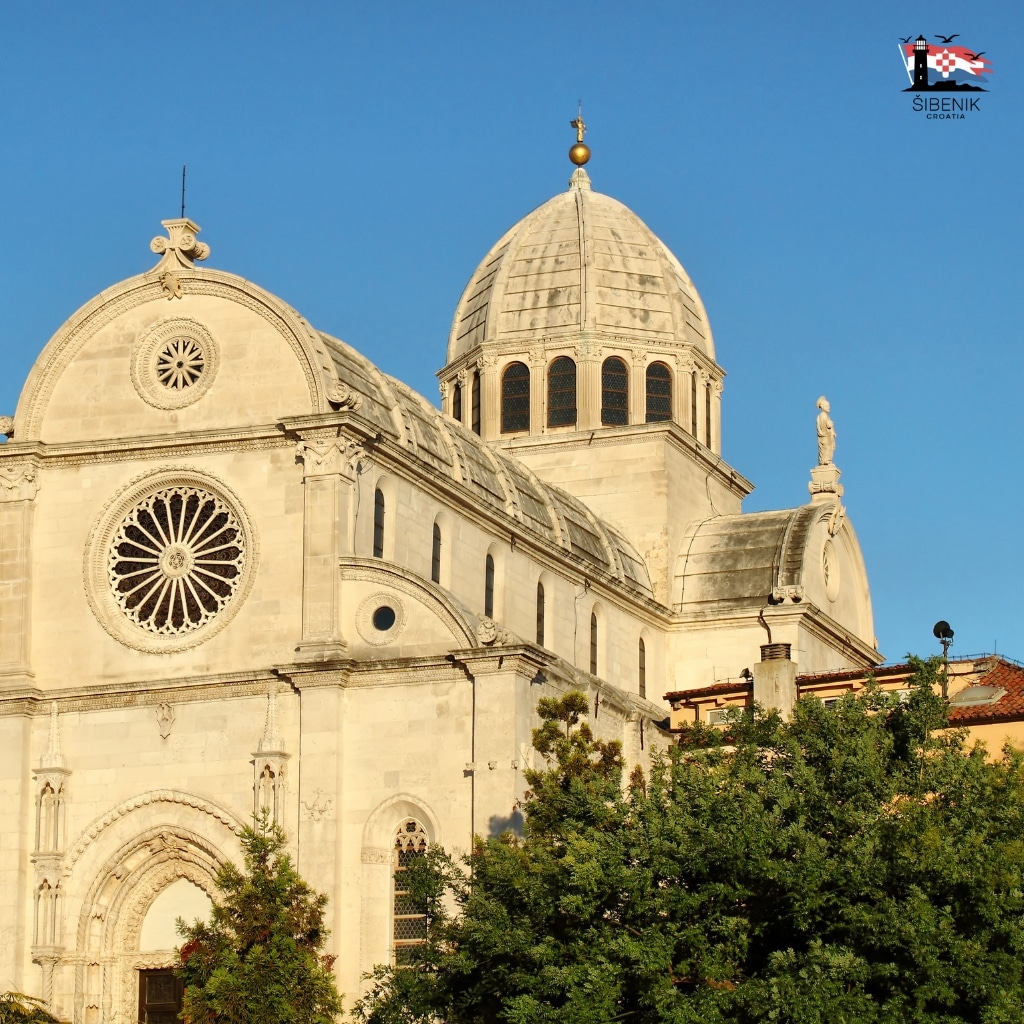Are you curious about Šibenik’s history? You’ve chosen a great spot on the Dalmatian coastline. Founded around 1066 AD, it’s the oldest Croatian settlement on the Adriatic Sea. With sites like the Cathedral of St James and St Nicholas Fortress, it’s a mix of culture, history, and beauty.
Walking through its streets, you’ll find stories of strength and change. It’s perfect for those wanting to dive into local heritage. From its architecture to events like the Medieval Fair, Šibenik offers unforgettable experiences.
Key Takeaways
- Šibenik is the oldest Croatian town on the Adriatic coast.
- Founded by Slavs in 1066 AD.
- Home to UNESCO Heritage sites like the Cathedral of St James.
- Known for its charming ambiance and beautiful streets.
- Features popular annual events like the Medieval Fair.
- Rich in culture and historical significance.
Introduction to Šibenik
Šibenik is a hidden gem on the stunning Dalmatian coast. It’s one of the most captivating Croatian coastal towns. This city is not just about breathtaking views and azure waters; it offers a rich tapestry of history and local culture.
The Šibenik introduction reveals a charming blend of the old and the new. It crafts an inviting atmosphere that captures the hearts of everyone who visits.
Walking along the serene waterfront promenade, you’ll find quaint cafes and colorful sailboats. With a population exceeding 40,000, Šibenik radiates a laid-back charm. The cobbled streets of the old town invite exploration, showing stunning historic buildings and bustling local businesses.
For anyone planning their journey, this travel guide to Šibenik promises to lead you through its scenic spots and cultural treasures. It ensures a memorable experience in this beautiful part of Croatia.
The Founding of Šibenik
Šibenik’s story began in 1066 AD, when it first showed up in history books. This beautiful city was founded by Croats, marking its place in the area. By 1169, it officially became a city, a big step in its history.
Šibenik’s roots go back to St. Michael’s Fortress, showing its strategic and rich past. Unlike many Croatian towns, Šibenik is deeply rooted in Slavic culture. This mix of early influences makes Croatian history even more interesting.
Through the years, the Venetians and Hungarians helped shape Šibenik. Yet, the city kept its unique charm and spirit. This shows the strong will of its people. Today, Šibenik is a key spot for those wanting to see real local life.
The Role of the Venetians in Šibenik’s Development
The history of Šibenik changed a lot during the Venetian rule in Croatia. This was from the 15th to the 18th centuries. The Venetians saw Šibenik as key and worked to make it strong.
They built amazing buildings, like St Nicholas Fortress. This is a big example of their work.
Šibenik became a mix of cultures thanks to the Venetians. They brought new ways to build and plan cities. This mix made Šibenik stand out from other Croatian towns.
- The Venetians built strong walls and fortifications.
- Venetian style was seen in public and private buildings.
- Cultural exchanges made the local community richer.
This time made Šibenik’s defenses stronger and its identity richer. Today, Šibenik’s unique character shows its Venetian past. It’s a great place for those who love history.
Historical Architecture: Landmarks of Šibenik
Šibenik is famous for its beautiful buildings that show its long history and culture. The Cathedral of St James and St Michael’s Fortress are key examples of Šibenik’s architecture. Each tells a different story of the city’s past.
The Cathedral of St James
The Cathedral of St James is a UNESCO World Heritage site. It’s known for its amazing Renaissance architecture. Built from stone, it has detailed designs and was finished in the 15th century.
The stone heads on the façade were made by Juraj Dalmatinac. They are a marvel of craftsmanship. This cathedral is not just a place of worship. It also marks a significant change in Šibenik’s architecture.
St Michael’s Fortress
St Michael’s Fortress is seen from many places in town. It offers a great view of Šibenik. This site has been used for many things, including as a royal seat for Croatian kings.
Visiting St Michael’s Fortress lets you see the city’s history up close. It shows the strategic role it played in the city’s past.
The Cultural Significance of Šibenik
Šibenik is a city where old and new meet beautifully. It hosts many festivals that show off its rich traditions. The Medieval Fair is a highlight, where people wear costumes from the past and perform music, dance, and theater.
The city’s food scene is a big part of its culture. Eating at local taverns lets visitors try traditional Dalmatian dishes. These meals are made with recipes that have been passed down for years.
Šibenik is full of art, music, and community spirit. Its festivals are not just fun but also important for keeping its culture alive. By joining in these events, visitors can really get to know Šibenik’s special character.
The History of Šibenik Through the Ages
Šibenik’s history is a rich tapestry shaped by many empires. It started with the Byzantines, who made it a key settlement. Later, the Habsburgs and Ottomans left their mark, changing the city’s look and culture.
The Venetians had a big impact on Šibenik history. They built strong defenses and beautiful buildings. These landmarks are a big draw for visitors today.
In the 20th century, Šibenik grew as a Yugoslav industrial center. This brought new jobs and ways of life. But, the city also faced hard times, like the Croatian War in the 1990s.
Looking at Šibenik’s past influences shows how it has changed. Each era added to its culture and buildings, making it a fascinating place today.
Šibenik in the Modern Era
In recent decades, modern Šibenik has seen big changes. These changes reflect the area’s shifting politics and society. During the Yugoslav era, the city grew industrially, moving beyond its maritime roots.
This growth improved Šibenik’s infrastructure and jobs. It brought new opportunities to the city.
Transformation During the Yugoslav Era
This era was a turning point for Šibenik. Investments in industry and commerce changed the local economy. Factories and businesses popped up, creating jobs and raising living standards.
The city’s lively atmosphere drew a diverse crowd. This diversity enriched Šibenik’s culture.
Impact of the Croatian War
The Croatian War deeply affected Šibenik, causing turmoil and damage. Battles, like the September Battle of 1991, left lasting scars. Yet, the war also showed the community’s strength and resilience.
After the war, Šibenik began to heal and rebuild. Today, it welcomes tourists with open arms. The city’s story of courage and recovery sets the stage for a bright future.
Tourism and Events Celebrating Šibenik’s Heritage
Šibenik is now a top spot for those looking for real experiences. Its rich history and bustling tourism scene draw many visitors every year. Events like the SHIP Music Festival and the Croatian Travel Festival highlight local traditions and creativity.
These festivals let tourists dive into Šibenik’s unique vibe. They get to see the city’s lively culture firsthand.
Šibenik’s beauty is a big draw for tourists. They can take guided tours through the city’s history or try the local food. The beautiful buildings and sea views make every visit special.
Being a filming spot for shows like Game of Thrones has made Šibenik famous worldwide. More people want to see its beauty and history through events and activities.
Conclusion
As we finish our journey through Šibenik, it’s clear this city is more than a place. It’s a living piece of history. From its founding by Croats to today’s vibrant culture, its beauty and spirit are evident everywhere.
Every corner of Šibenik has a story to tell. It’s a city of resilience and innovation. It invites travelers to join its ongoing story.
If you’re planning to visit Šibenik, you’ll find many amazing things to see and do. The Cathedral of St James and St Michael’s Fortress are just the beginning. The city’s lively events and festivals add to its charm, making it a top spot for authentic experiences.
Šibenik is a standout in Croatia, showing the beauty and strength of its past. Whether you love the coast or the culture, it offers an adventure you won’t forget. Let Šibenik’s history inspire your travels.
FAQ
What is the best time to visit Šibenik?
The best time to visit Šibenik is in spring and early fall. The weather is mild, and there are fewer tourists. Summer is hot but lively with festivals and events.
What are the must-see attractions in Šibenik?
You must see the Cathedral of St James and St Michael’s Fortress. The old town’s cobbled streets are also a must. The waterfront promenade offers beautiful views and cafes.
Are there any local festivals I should attend?
Yes! Don’t miss the Medieval Fair and SHIP Music Festival. They showcase traditional music, art, and food.
What type of local cuisine can I try in Šibenik?
Try traditional Dalmatian dishes like fresh seafood, risotto, and local wines. Local taverns offer the best dining experience.
How can I get around Šibenik?
Walking is the best way to see the old town. For other attractions, use public transport or rent a bike. This way, you can enjoy the coastal views.
What unique experiences can I find in Šibenik?
Explore history with guided tours or learn to cook Dalmatian dishes. A sailing trip along the coast offers breathtaking views of the Adriatic Sea.

